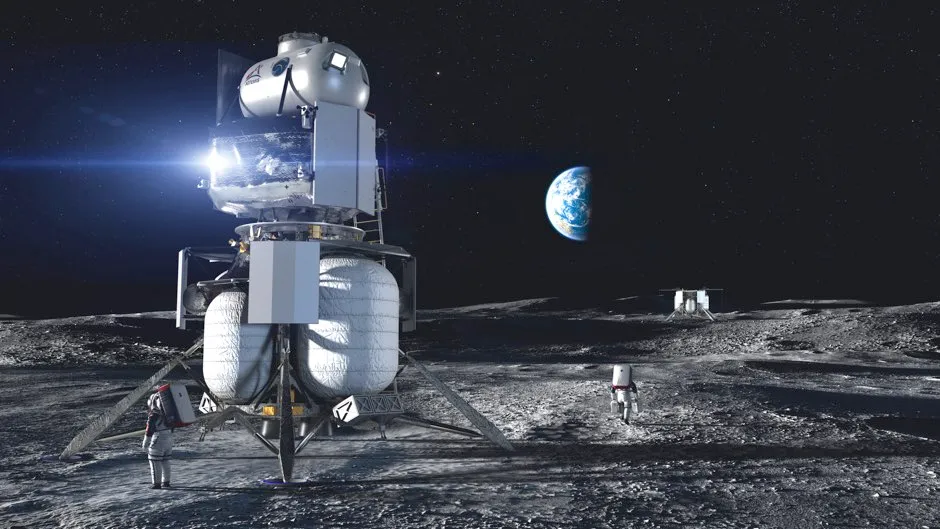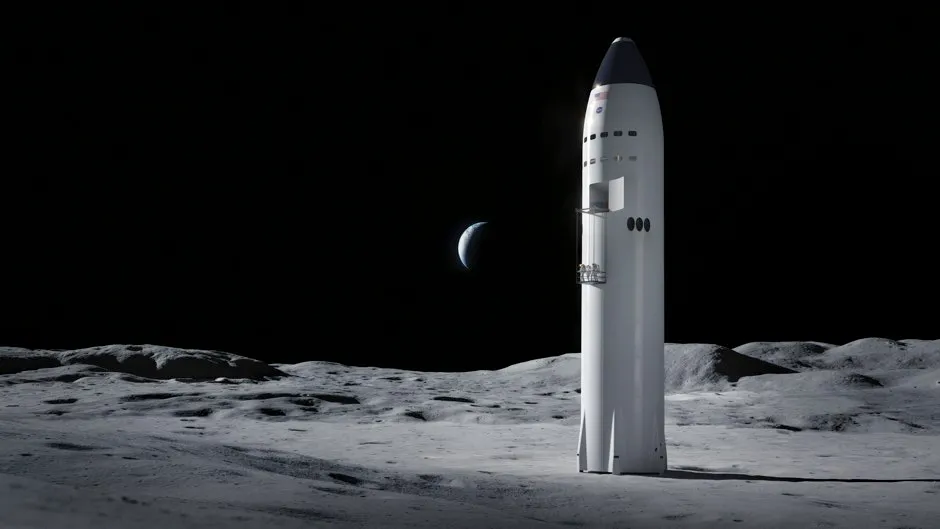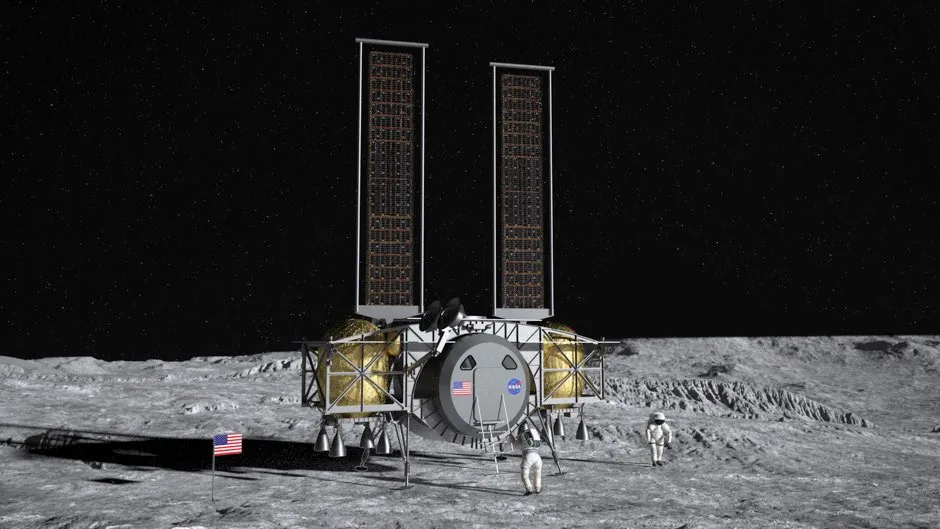NASA has selected three US companies to design and develop lunar landers that could take astronauts back to the Moon as part of their Artemis programme. These companies now share contracts worth a total of $967 million, which will fund 10 month’s work to refine their lander concepts in collaboration with NASA.
In February 2021, NASA will choose which company, or companies, will proceed to initial demonstration missions.
The lion’s share of the contract ($579 million) goes to Blue Origin, owned by Amazon’s CEO Jeff Bezos. Elon Musk’s SpaceX has been awarded $135 million, and Dynetics from Huntsville, Alabama will receive $253 million.
Read more about NASA:
- NASA to resume launching astronauts from US soil
- Marsquakes caused by tectonic activity, NASA’s InSight probe confirms
“We are on our way,” said DouglasLoverro, NASA’s associate administrator for Human Explorations and Operations Mission Directorate in Washington, at the time of the announcement. “With these awards we begin an exciting partnership with the best of industry to accomplish the nation’s goals.”
The designs are all different from one another. Blue Origin is developing a spacecraft that looks similar to the old Apollo designs. It uses a descent module, mated to an ascent module with an attached crew compartment.

The descent modulecarries the engines needed to safely land on the Moon and will be left behind when the time comes to return home. The ascent module will then propel the crew compartment back up into space.
Dynetics is developing a single descent and ascent lander that puts the engines on either side of the crew compartment. It is a general design that could be launched on a number of commercial rockets, and according to the documentation released by NASA was judged to have the best technical and managerial ratings of the three chosen proposals.
SpaceX has received funding for their fully reusable launch and landing system called Starship. It comprises the Starship spacecraft, that looks akin to the lunar rockets imagined by filmmakers in the 1950s, and their proposed Super Heavy rocket. Starship would be a fully reusable rocket ship that Musk hopes will eventually carry people to Mars.
Read more about future Moon missions:
- Race to the Moon: Inside China's plans to build a lunar base
- Why we need to go back to the Moon
- Who will be next to land on the Moon?
NASA’s Moon landing programme is called Artemis. The name derives from Greek mythology, in which Artemis was Apollo’s twin sister and the goddess of the Moon. The programme is pledged to land the first woman and next manon the surface of the Moon by 2024.
This ambitious goal was announced last year by the American Vice President Mike Pence. It came as a surprise because NASA had been working towards an international mission to the Moon in 2028.
Pulling the expected landing date forward by four years means that the schedule is punishing, perhaps even unachievable.
The Artemis programme
For the Apollo programme in the late 1960s and early 1970s, it took the company Grumman Aircraft seven years to design and build the lunar lander. It also took more than $21 billion of government money. This time, NASA has neither that much time nor money.
“I personally believe that to set a target is the only way to get things done,” says David Baker, a former NASA engineer who worked on the Apollo Moon landings, and who is now the editor of Spaceflight, the journal of the British Interplanetary Society, “but getting to the Moon by 2028 was a big enough task by itself. You can call me a cynic but I think I’m being a realist on this.”
To compensate for lack of time, NASA said at the 30 April announcement that spacecraft technology has moved on since the 60s and not everything now needs to be invented. Some parts of the lander could simply be bought ‘off-the-shelf’ and integrated. Hence, it should also be cheaper.

To further reduce the cost to NASA, the American space agency has partnered with private companies that will shoulder some of the cost in return for the promise of lucrative future contracts.
Although NASA have not revealed the exact way the Artemis missions will run, saying that working this out will be part of the next 10 month’s development work, they have said the missions are unlikely to use a space station that is being developed for lunar orbit called the Lunar Orbital Platform Gateway.
Read more about the Moon:
When the plan was to land in 2028, astronauts were going to launch from Earth in NASA’s newly developed Orion capsule and dock with the gateway. From there they would transfer to a lunar lander that would act like a taxi from lunar orbit to the surface and back again.
Astronauts on the gateway could also drive rovers remotely and perform other lunar experiments that didn’t require their personal presence on the surface.
NASA has reached a number of agreements with international partners such as the European Space Agency (ESA), Russia, Japan and Canada, to supply different modules for the gateway. For example, ESA is working on the European System Providing Refueling, Infrastructure and Telecommunications (ESPRIT) service module, and the International Habitation Module (iHAB) in collaboration with the Japanese.

When the new date of 2024 was announced, NASA quickly awarded contracts for the gateway’s Power and Propulsion Element (PPE), and the Minimal Habitation Module (MHM) with US companies. Now, however, it looks likely that the 2024 mission will bypass the station altogether, although NASA say they remain committed to building the gateway to support future missions.
The first launch in the push for a 2024 landing is expected to happen in November next year. Artemis I will be the maiden flight of America’s big new rocket, the Space Launch System. It will carry an empty Orion crew capsule on a 25-day mission in lunar orbit to test the capsule and the rocket.
Artemis II will follow in 2022 and will carry a crew of four around the Moon. This will be the first time that humans have been in the vicinity of the Moon since 1972. The third mission, Artemis III, will place people on the surface.
But the US congress has yet to approve NASA’s plans and budget. And there is a political fight brewing because in January, senior members of the House Science Committee sought to direct NASA to have “full ownership” of the necessary lunar lander, or Human Landing System as NASA prefer to call it. This is clearly not the route that NASA has taken.
In a statement released the day after the announcement, the chair of the House Science Committee, Rep. Eddie Bernice Johnson (D-Texas), stated, “I am troubled that NASA has decided to ignore congressional intent and instead press forward with Human Landing System awards to try to meet an arbitrary 2024 lunar landing deadline.”
There are clearly as many political, as well as technical hurdles to overcome if NASA are to stand any chance of getting to the Moon in 2024.
Reader Q&A: How long does it take to get to the Moon if you drive at 60mph?
Asked by: Matt B, Glastonbury
Astronomer Fred Hoyle was the first to point out that if you could drive a car upwards at 95km/h (60mph), it would only take about an hour to get into space.
To get to the Moon would take a little longer though, since it's 400,000km (250,000 miles) away - around 10 times the circumference of the Earth. So it would take as long as driving around the world 10 times - just under six months.
Your only real problem (apart from the lack of air for your lungs and for burning the petrol) would be finding a garage to refuel - and that has a loo!
Read more: